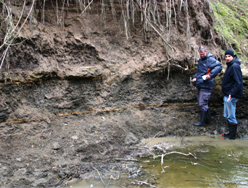
Figure 10. Cottonmouth Creek waterfall drapes over the resistant sandstone complex with reworked Chicxulub impact spherules at the base. The original impact spherule layer is present in a 3 cm thick yellow layer in claystones about 60 cm below the sandstone complex. Microfossils date the impact spherule layer as the base of zone CF1, or ~300 ky before the mass extinction.
Deccan Volcanism - Real Cause for the KT Mass Extinction?
Despite the rancorous debate of the 1980s, the study of Deccan volcanism continued to be most actively pursued by geophysicist Vincent Courtillot and his collaborators at the Institut de Physique du Globe in Paris. At the beginning, Courtillot advocated Deccan volcanism not as alternative hypothesis to an impact, but as contributing factor in addition to impact (Courtillot et al., 1986, 1988). As evidence accumulated the discussions gradually shifted towards volcanism as dominant long-term role in the mass extinction and the impact as the “last straw” at the KTB (Vandamme and Courtilot, 1992;Courtillot, 1999).
But demonstrating that Deccan volcanism was the principal cause of the KT mass extinction faced daunting scientific hurdles. For over two decades the main Deccan eruptions were shown to have occurred over less than 800,000 years in magnetic polarity C29r, spanning the Cretaceous-Tertiary boundary (Courtillot et al., 1986, 1988; Duncan and Pyle, 1988; Vandamme and Courtilot, 1992). Determining where within this major eruptive phase the KT mass extinction occurred remained problematic. For this reason, models estimating the biotic and environmental consequences generally underestimated the duration, rate and quantity of Deccan gas emissions by orders of magnitude, leading to conclusions that volcanism could not have been one of the major causes for the KT mass extinction.
Today, this view is rapidly and radically changing principally due to three recent studies. Chenet et al. (2007, 2008) estimated that the bulk (80%) of the 3500 m thick Deccan traps was deposited over a very short time period - possibly less than 10,000 years, with most of this time represented by periods of quiescence between volcanic eruptions (e.g., intertrappean sedimentation). The entire Deccan lava pile erupted in three phases with the first and smallest phase at 67.4Ma, the main phase at or near the KTB and the last smaller phase at the C29r/C29n transition in the early Danian. These conclusion were reached based on the largest single database (169 sites) employed to date and integrating palaeomagnetic analysis, K-Ar and Ar/Ar dating, chemostratigraphy and petrology.
Self et al. (2008a,b) measured sulphur and chlorine gas concentrations in rare glass inclusions of crystals in Deccan lavas and determined that 1km3 of lava released between 3.5 to 5.4 teragrams of SO
2 and one teragram of HCl. In modern basaltic eruptions both these gases cause well documented climatic and environmental effects. The massive Deccan eruptions and huge amounts of S and Cl gases released over a very short period at the end of the Cretaceous would have had severe environmental consequences.
Keller et al. (2008a) discovered that the KT mass extinction coincided with the end of the main phase of Deccan volcanism. Their results are based on sedimentologic, microfacies and biostratigraphic data of 4-9m-thick intertrappean sediments in four quarry outcrops in the Rajahmundry area of the Krishna-Godavari Basin of southeastern India. In this area Deccan eruptions, known as the Rajahmundry traps, mark the end of the main phase of Deccan volcanism and the world’s longest lava flows extending 1300km across the Indian continent and into the Gulf of Bengal. Sediments immediately below mark the mass extinction in planktic foraminifera. Sediments directly overlying the lower trap basalts contain early Danian planktic foraminiferal assemblages of zone P1a, which mark the evolution in the aftermath of the KT mass extinction. These results were corroborated in intertrappean sediments between C29r and the C29r/C29n transition in central India (Jhilmili, Chhindwara District, Madhya Pradesh, Keller et al., 2009a,b).
The results of these studies strongly suggest that Deccan volcanism played a critical role in the KT mass extinction, which occurred after the last mega-pulse of the main phase of Deccan volcanism. Although the kill mechanism(s) and precise nature of environmental catastrophes due volcanic gas emissions remains to be determined, Deccan volcanism has emerged as a credible cause for the KT mass extinction and the most serious challenge to the impact hypothesis. Moreover, the discovery of rapid and voluminous Deccan eruptions at KT time suggests that Ir and other PGE contributions may have been far greater than originally assumed and could account for at least some Ir anomalies.